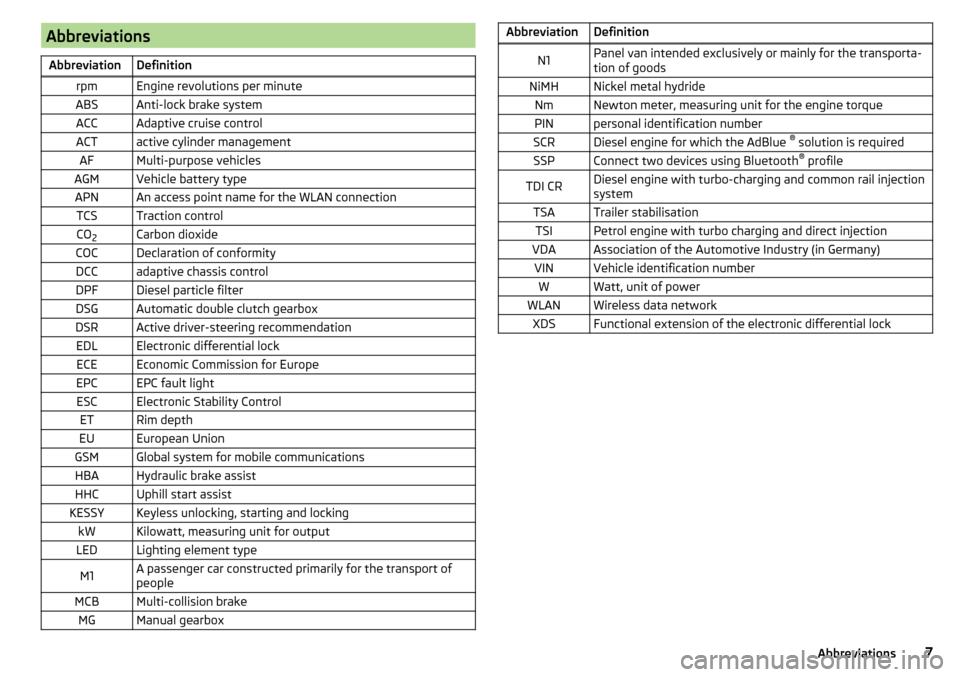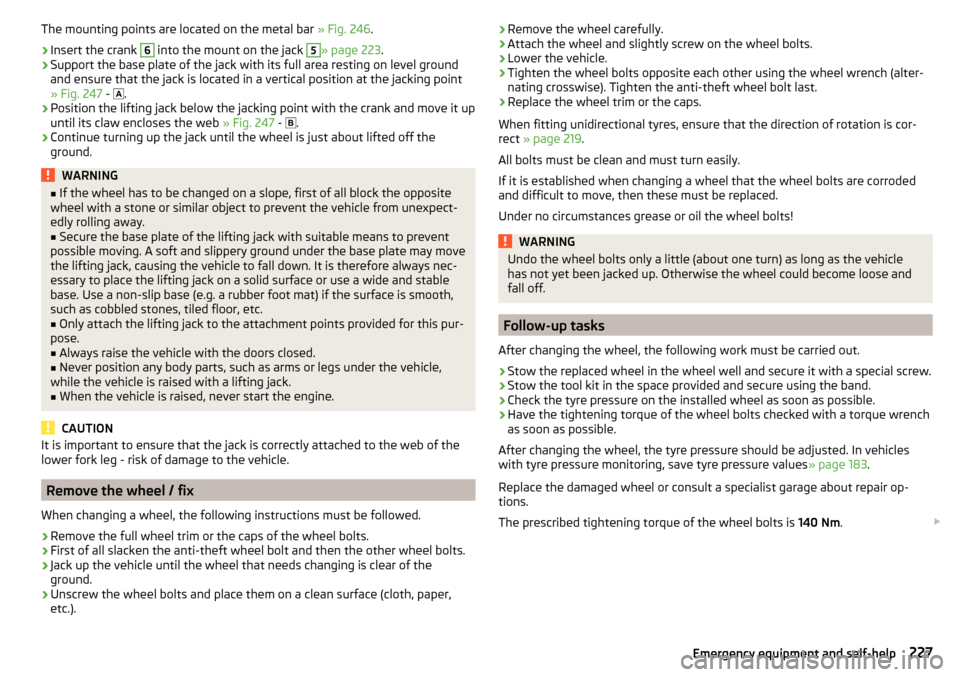torque SKODA SUPERB 2015 3.G / (B8/3V) Owner's Manual
[x] Cancel search | Manufacturer: SKODA, Model Year: 2015, Model line: SUPERB, Model: SKODA SUPERB 2015 3.G / (B8/3V)Pages: 276, PDF Size: 42.14 MB
Page 9 of 276

AbbreviationsAbbreviationDefinitionrpmEngine revolutions per minuteABSAnti-lock brake systemACCAdaptive cruise controlACTactive cylinder managementAFMulti-purpose vehiclesAGMVehicle battery typeAPNAn access point name for the WLAN connectionTCSTraction controlCO2Carbon dioxideCOCDeclaration of conformityDCCadaptive chassis controlDPFDiesel particle filterDSGAutomatic double clutch gearboxDSRActive driver-steering recommendationEDLElectronic differential lockECEEconomic Commission for EuropeEPCEPC fault lightESCElectronic Stability ControlETRim depthEUEuropean UnionGSMGlobal system for mobile communicationsHBAHydraulic brake assistHHCUphill start assistKESSYKeyless unlocking, starting and lockingkWKilowatt, measuring unit for outputLEDLighting element typeM1A passenger car constructed primarily for the transport of
peopleMCBMulti-collision brakeMGManual gearboxAbbreviationDefinitionN1Panel van intended exclusively or mainly for the transporta-
tion of goodsNiMHNickel metal hydrideNmNewton meter, measuring unit for the engine torquePINpersonal identification numberSCRDiesel engine for which the AdBlue ®
solution is requiredSSPConnect two devices using Bluetooth ®
profileTDI CRDiesel engine with turbo-charging and common rail injection
systemTSATrailer stabilisationTSIPetrol engine with turbo charging and direct injectionVDAAssociation of the Automotive Industry (in Germany)VINVehicle identification numberWWatt, unit of powerWLANWireless data networkXDSFunctional extension of the electronic differential lock7Abbreviations
Page 229 of 276

The mounting points are located on the metal bar » Fig. 246.›
Insert the crank
6
into the mount on the jack
5
» page 223 .
›
Support the base plate of the jack with its full area resting on level ground
and ensure that the jack is located in a vertical position at the jacking point
» Fig. 247 -
.
›
Position the lifting jack below the jacking point with the crank and move it up
until its claw encloses the web » Fig. 247 -
.
›
Continue turning up the jack until the wheel is just about lifted off the
ground.
WARNING■ If the wheel has to be changed on a slope, first of all block the opposite
wheel with a stone or similar object to prevent the vehicle from unexpect-
edly rolling away.■
Secure the base plate of the lifting jack with suitable means to prevent
possible moving. A soft and slippery ground under the base plate may move
the lifting jack, causing the vehicle to fall down. It is therefore always nec-
essary to place the lifting jack on a solid surface or use a wide and stable
base. Use a non-slip base (e.g. a rubber foot mat) if the surface is smooth,
such as cobbled stones, tiled floor, etc.
■
Only attach the lifting jack to the attachment points provided for this pur-
pose.
■
Always raise the vehicle with the doors closed.
■
Never position any body parts, such as arms or legs under the vehicle,
while the vehicle is raised with a lifting jack.
■
When the vehicle is raised, never start the engine.
CAUTION
It is important to ensure that the jack is correctly attached to the web of the
lower fork leg - risk of damage to the vehicle.
Remove the wheel / fix
When changing a wheel, the following instructions must be followed.
›
Remove the full wheel trim or the caps of the wheel bolts.
›
First of all slacken the anti-theft wheel bolt and then the other wheel bolts.
›
Jack up the vehicle until the wheel that needs changing is clear of the
ground.
›
Unscrew the wheel bolts and place them on a clean surface (cloth, paper,
etc.).
› Remove the wheel carefully.›Attach the wheel and slightly screw on the wheel bolts.›
Lower the vehicle.
›
Tighten the wheel bolts opposite each other using the wheel wrench (alter-
nating crosswise). Tighten the anti-theft wheel bolt last.
›
Replace the wheel trim or the caps.
When fitting unidirectional tyres, ensure that the direction of rotation is cor-
rect » page 219 .
All bolts must be clean and must turn easily.
If it is established when changing a wheel that the wheel bolts are corroded and difficult to move, then these must be replaced.
Under no circumstances grease or oil the wheel bolts!
WARNINGUndo the wheel bolts only a little (about one turn) as long as the vehicle
has not yet been jacked up. Otherwise the wheel could become loose and
fall off.
Follow-up tasks
After changing the wheel, the following work must be carried out.
›
Stow the replaced wheel in the wheel well and secure it with a special screw.
›
Stow the tool kit in the space provided and secure using the band.
›
Check the tyre pressure on the installed wheel as soon as possible.
›
Have the tightening torque of the wheel bolts checked with a torque wrench
as soon as possible.
After changing the wheel, the tyre pressure should be adjusted. In vehicles
with tyre pressure monitoring, save tyre pressure values » page 183.
Replace the damaged wheel or consult a specialist garage about repair op-
tions.
The prescribed tightening torque of the wheel bolts is 140 Nm.
227Emergency equipment and self-help
Page 230 of 276

WARNING■If the wheel bolts are tightened to a too low tightening torque, the rim
can come loose when the car is moving. A tightening torque which is too
high can damage the bolts and threads and this can result in permanent
deformation of the contact surfaces on the rim.■
Drive cautiously and only at a moderate speed until the tightening torque
has been checked.
Puncture repair kit
Introduction
This chapter contains information on the following subjects:
Components of the puncture repair kits
228
General information
229
Preparations for using the breakdown kit
229
Sealing and inflating the tyre
229
Notes for driving with repaired tyres
230
Use the breakdown kit to reliably repair tyre damage caused by foreign bodies
or a puncture with diameters up to approx. 4 mm.
Performing a repair with the breakdown kit not at all intended to replace a
permanent repair on the tyre. Its purpose is to get you to the nearest specialist
garage.
The wheel must not be removed during repair.
Do not remove foreign bodies , which have penetrated the wheel profile from
the tyre (e.g. screws or nails).
Immediately replace the tyre that was repaired using the breakdown kit, or
consult a specialist garage about repair options.
WARNING■ The sealant is hazardous to heath. Remove immediately if it comes into
contact with the skin.■
Observe the manufacturer's usage instructions for the breakdown kit.
Note
A new bottle of sealant can be purchased from ŠKODA Original Parts.Components of the puncture repair kitsFig. 248
Principle sketch: Components of the breakdown kit
Read and observe
on page 228 first.
Kit components » Fig. 248
Sticker with speed designation “max. 80 km/h”/“max. 50 mph” Valve remover
Inflation hose with plug
Air compressor
Button for releasing the tyre pressure
12 volt cable connector
Tyre inflation hose
Tyre inflation pressure indicator
ON and OFF switch
Tyre inflation bottle with sealing agent
Replacement valve core
The valve remover
2
has a slot at its lower end which fits into the valve core.
The kit is located in a box under the floor covering in the luggage compart-
ment. The kit contains a sealant and an air compressor.
Note
The declaration of conformity is included with the air compressor or the log
folder.1234567891011228Do-it-yourself
Page 254 of 276

Vehicle-specific information depending on engine type
Introduction
This chapter contains information on the following subjects:
1.4 l/92 kW TSI engine252
1.4 l/110 kW TSI ACT engine
252
1.4 l/110 kW TSI engine
253
1.8 l/132 kW TSI engine
253
2.0 l/162 kW TSI engine
2532.0 l/206 kW TSI engine2541.6 l/88 kW TDI CR engine254
2.0 l/110 kW TDI CR engine
254
2.0 l/130 kW TDI CR engine
255
2.0 l/140 kW TDI CR engine
255The values given have been determined in accordance with the rules and conditions specified in statutory or technical regulations for determining operational
and technical data for motor vehicles.The emissions standard is detailed in the technical vehicle documentation as well as in the certificate of conformity (COC document), which can be obtained from a ŠKODA partner a)
.a)
Only valid for some countries and some models.
1.4 l/92 kW TSI engine
Output (kW/rpm)92/5000-6000Maximum torque (Nm/rpm)200/1400-4000Number of cylinders/displacement (cm 3
)4/1395BodySuperbSuperb EstateTransmissionMGMGTop speed (km/h)208206Acceleration 0-100 km/h (s)9.910.0
1.4 l/110 kW TSI ACT engine
Output (kW/rpm)110/5000-6000Maximum torque (Nm/rpm)250/1500-3500Number of cylinders/displacement (cm 3
)4/1395BodySuperbSuperb EstateTransmissionMGMG 4x4DSGMGMG 4x4DSGTop speed (km/h)220215220218213218Acceleration 0-100 km/h (s)8.69.08.88.79.18.9252Technical data
Page 255 of 276

1.4 l/110 kW TSI engineOutput (kW/rpm)110/5000-6000Maximum torque (Nm/rpm)250/1500-3500Number of cylinders/displacement (cm3
)4/1395BodySuperbSuperb EstateTransmissionMGDSGMGDSGTop speed (km/h)220220218218Acceleration 0-100 km/h (s)8.68.88.78.9
1.8 l/132 kW TSI engine
Output (kW/rpm)MG132/4000-6200DSG132/5100-6200Maximum torque (Nm/rpm)MG320/1450-3900DSG250/1250-5000Number of cylinders/displacement (cm 3
)4/1798BodySuperbSuperb EstateTransmissionMGDSGMGDSGTop speed (km/h)232232230230Acceleration 0-100 km/h (s)8.08.18.18.2
2.0 l/162 kW TSI engine
Output (kW/rpm)162/4500-6200Maximum torque (Nm/rpm)350/1500-4400Number of cylinders/displacement (cm 3
)4/1984BodySuperbSuperb EstateTransmissionDSGDSGTop speed (km/h)245243Acceleration 0-100 km/h (s)7.07.1253Technical data
Page 256 of 276

2.0 l/206 kW TSI engineOutput (kW/rpm)206/5600-6500Maximum torque (Nm/rpm)350/1700-5600Number of cylinders/displacement (cm3
)4/1984BodySuperbSuperb EstateTransmissionDSG 4x4DSG 4x4Top speed (km/h)250250Acceleration 0-100 km/h (s)5.85.8
1.6 l/88 kW TDI CR engine
Output (kW/rpm)88/3600-4000Maximum torque (Nm/rpm)250/1600-3250Number of cylinders/displacement (cm 3
)4/1598BodySuperbSuperb EstateTransmissionMGMG (Green Line)DSGMGMG (Green Line)DSGTop speed (km/h)206209206204206204Acceleration 0-100 km/h (s)10.911.011.011.011.111.1
2.0 l/110 kW TDI CR engine
Output (kW/rpm)110/3500-4000Maximum torque (Nm/rpm)340/1750-3000Number of cylinders/displacement (cm 3
)4/1968BodySuperbSuperb EstateTransmissionMGMG 4x4DSGMGMG 4x4DSGTop speed (km/h)220215218218213216Acceleration 0-100 km/h (s)8.89.08.98.99.19.0254Technical data
Page 257 of 276

2.0 l/130 kW TDI CR engineOutput (kW/rpm)130/3700-4000Maximum torque (Nm/rpm)380/1750-3400Number of cylinders/displacement (cm3
)4/1968BodySuperbSuperb EstateTransmissionDSGDSGTop speed (km/h)222220Acceleration 0-100 km/h (s)8.48.5
2.0 l/140 kW TDI CR engine
Output (kW/rpm)140/3500-4000Maximum torque (Nm/rpm)400/1750-3250Number of cylinders/displacement (cm 3
)4/1968BodySuperbSuperb EstateTransmissionMGDSGDSG 4x4MGDSGDSG 4x4Top speed (km/h)237235230235233228Acceleration 0-100 km/h (s)8.07.77.68.17.87.7255Technical data